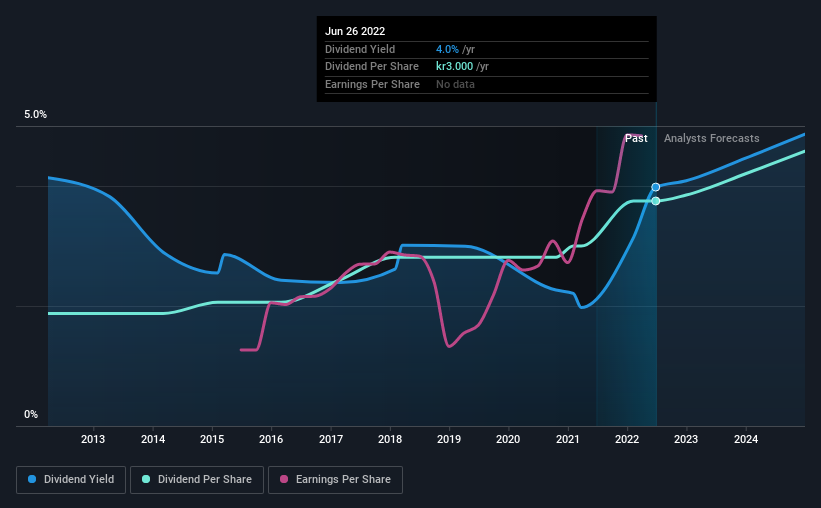Husqvarna (STO:HUSQ B) Has Announced That It Will Be Increasing Its Dividend To kr2.00

Husqvarna AB (publ)'s (STO:HUSQ B) dividend will be increasing to kr2.00 on 14th of October. This will take the dividend yield from 4.0% to 4.0%, providing a nice boost to shareholder returns.
Check out our latest analysis for Husqvarna
Husqvarna's Payment Has Solid Earnings Coverage
If the payments aren't sustainable, a high yield for a few years won't matter that much. Before making this announcement, Husqvarna was paying a whopping 530% as a dividend, but this only made up 39% of its overall earnings. A cash payout ratio this high could put the dividend under pressure and force the company to reduce it in the future if it were to run into tough times.
Looking forward, earnings per share is forecast to fall by 12.2% over the next year. Assuming the dividend continues along recent trends, we believe the payout ratio could be 47%, which we are pretty comfortable with and we think is feasible on an earnings basis.

Husqvarna Has A Solid Track Record
Even over a long history of paying dividends, the company's distributions have been remarkably stable. Since 2012, the first annual payment was kr1.50, compared to the most recent full-year payment of kr3.00. This implies that the company grew its distributions at a yearly rate of about 7.2% over that duration. Companies like this can be very valuable over the long term, if the decent rate of growth can be maintained.
The Dividend Looks Likely To Grow
Investors could be attracted to the stock based on the quality of its payment history. Husqvarna has seen EPS rising for the last five years, at 14% per annum. Growth in EPS bodes well for the dividend, as does the low payout ratio that the company is currently reporting.
Our Thoughts On Husqvarna's Dividend
Overall, this is probably not a great income stock, even though the dividend is being raised at the moment. With cash flows lacking, it is difficult to see how the company can sustain a dividend payment. We don't think Husqvarna is a great stock to add to your portfolio if income is your focus.
Market movements attest to how highly valued a consistent dividend policy is compared to one which is more unpredictable. At the same time, there are other factors our readers should be conscious of before pouring capital into a stock. As an example, we've identified 2 warning signs for Husqvarna that you should be aware of before investing. Looking for more high-yielding dividend ideas? Try our collection of strong dividend payers.
If you're looking to trade Husqvarna, open an account with the lowest-cost platform trusted by professionals, Interactive Brokers.
With clients in over 200 countries and territories, and access to 160 markets, IBKR lets you trade stocks, options, futures, forex, bonds and funds from a single integrated account.
Enjoy no hidden fees, no account minimums, and FX conversion rates as low as 0.03%, far better than what most brokers offer.
Sponsored ContentValuation is complex, but we're here to simplify it.
Discover if Husqvarna might be undervalued or overvalued with our detailed analysis, featuring fair value estimates, potential risks, dividends, insider trades, and its financial condition.
Access Free AnalysisHave feedback on this article? Concerned about the content? Get in touch with us directly. Alternatively, email editorial-team (at) simplywallst.com.
This article by Simply Wall St is general in nature. We provide commentary based on historical data and analyst forecasts only using an unbiased methodology and our articles are not intended to be financial advice. It does not constitute a recommendation to buy or sell any stock, and does not take account of your objectives, or your financial situation. We aim to bring you long-term focused analysis driven by fundamental data. Note that our analysis may not factor in the latest price-sensitive company announcements or qualitative material. Simply Wall St has no position in any stocks mentioned.
About OM:HUSQ B
Husqvarna
Produces and sells outdoor power products, watering products, and lawn care power equipment.
Adequate balance sheet slight.
Similar Companies
Market Insights
Community Narratives



